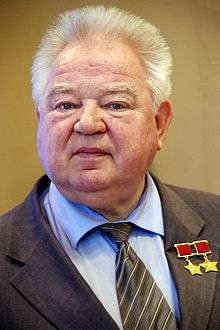Georgy Grechko
Georgy Mikhaylovich Grechko (Russian: Георгий Михайлович Гречко; 25 May 1931 – 8 April 2017) was a Soviet cosmonaut who flew on several space flights including Soyuz 17, Soyuz 26, and Soyuz T-14.[1]
Georgy Mikhaylovich Grechko | |
|---|---|
 Grechko in 2011 | |
| Born | May 25, 1931 |
| Died | April 8, 2017 (aged 85) |
| Nationality | Soviet |
| Occupation | Engineer |
| Awards | Hero of the Soviet Union (2) |
| Space career | |
| Cosmonaut | |
Time in space | 134d 20h 32m |
| Selection | Civilian Specialist Group 3 |
| Missions | Soyuz 17, Salyut 4 Soyuz 26, Salyut 6 EO-1, Soyuz 27, Soyuz T-14, Salyut 7 EP-5, Soyuz T-13 |
Biography
Grechko graduated from the Leningrad Institute of Mechanics with a doctorate in mathematics. He was a member of Communist Party of the Soviet Union. He went on to work at Sergei Korolev's design bureau and from there was selected for cosmonaut training for the Soviet Moon programme. When that program was cancelled, he went on to work on the Salyut space stations.
Grechko made the first spacewalk in an Orlan space suit on 20 December 1977 during the Salyut 6 EO-1 mission.
He was twice awarded the medal of Hero of the Soviet Union.
He resigned from the space programme in 1992 to lecture on atmospheric physics at the Russian Academy of Sciences. Grechko has written his memoirs as "Космонавт No. 34: От лучины до пришельцев," (Cosmonaut No. 34 From Splinter to Aliens) Olma Media Grupp, Moscow, 2013.
A minor planet 3148 Grechko discovered by Soviet astronomer Nikolai Stepanovich Chernykh in 1979 is named after him.[2]
Grechko had a brief cameo role in Richard Viktorov's 1981 film Per Aspera Ad Astra, and as a result attained pop culture status in his home city of Leningrad.[3] He also appeared in the 1979 film Under the Constellation Gemini.
Grechko, along with Alexei Leonov, Vitaly Sevastyanov, and Rusty Schweickart established the Association of Space Explorers in 1984. Membership is open to all people who have flown in outer space.
Grechko died aged 85 as a result of several chronic illnesses. He was survived by wife Lyudmila and daughter Olga.[1]
Honours and awards
- Twice Hero of the Soviet Union
- Pilot-Cosmonaut of the USSR
- Three Orders of Lenin
- Medal "For Merit in Space Exploration"
- Medal "For Distinguished Labour"
- Jubilee Medal "In Commemoration of the 100th Anniversary since the Birth of Vladimir Il'ich Lenin"
- Medal "For the Development of Virgin Lands"
- Honorary membership in the Danish Astronautical Society[4]
- Distinguished Member, Association of Space Explorers
References
- Умер космонавт Георгий Гречко. tass.ru (8 April 2017)
- Dictionary of Minor Planet Names – p.260
- Official website of the Danish Astronautical Society Archived 14 July 2014 at the Wayback Machine
Literature
| Wikimedia Commons has media related to Georgi Grechko. |
- "Cosmonaut No. 34. From a sliver to aliens" (G. M. Grechko, 2013, OLMA Media Group)
- S. P. Korolev. Encyclopedia of life and creativity" – edited by C. A. Lopota, RSC Energia. S. P. Korolev, 2014 ISBN 978-5-906674-04-3
- The official website of the city administration Baikonur – Honorary citizens of Baikonur